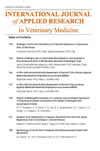Histological and Molecular Evaluation of Raw Meatball Products
4区 农林科学
Q4 Veterinary
International Journal of Applied Research in Veterinary Medicine
Pub Date : 2022-11-14
DOI:10.30782/jrvm.1170017
引用次数: 0
Abstract
Meat is an important source of protein with high biological value. Due to this importance, the production and consumption of meat and meat products such as minced meat, salami, sausage, meatballs and roasted meat has been increasing rapidly in recent years. In order to earn more money, some companies sell animal meats that are not consumed by the society by mixing them into meat products without considering the health, habits, ethical and cultural values of people. In this study, it is aimed to examine whether there are undesirable tissues and muscle tissue belonging to different species in meat products by making histological and molecular evaluations in raw meatball products offered for sale. Evaluations were made by taking samples of raw meatball products offered for sale by 6 different well known supermarkets. In the results we obtained, it was observed that the integrity of the muscle tissue was not impaired in sample 1, but the presence of cartilage fragments in places. In sample 2, different sizes of tendon fragments and nerve fiber bundles were detected, with less muscle tissue. In sample number 3, it was observed that the integrity of the muscle tissue was not impaired and the spice pieces were excessive. In sample number 4, it was observed that the integrity of the muscle tissue was partially damaged. In sample 5, large tendon fragments and abundant connective tissue were detected. In sample 6, an image was detected, suggesting that it was caused by too much use of the additive. In the RT-PCR results, no tissue belonging to different species was found in any of the 6 samples we received. These results, in addition to being inappropriate in terms of public health and consumer rights, also appear as attempts to gain unfair financial gain.生肉丸制品的组织学和分子评价
肉类是蛋白质的重要来源,具有很高的生物学价值。由于这一重要性,近年来肉类和肉制品(如肉末、意大利腊肠、香肠、肉丸和烤肉)的生产和消费迅速增加。为了赚更多的钱,一些公司在不考虑人们的健康、习惯、道德和文化价值观的情况下,将不被社会消费的动物肉混入肉类产品中出售。在本研究中,旨在通过对销售的生肉丸产品进行组织学和分子评价,以检查肉制品中是否存在不同物种的不良组织和肌肉组织。评估是通过对6家知名超市出售的生肉丸产品进行抽样进行的。在我们得到的结果中,我们观察到,在样本1中,肌肉组织的完整性没有受损,但在某些地方存在软骨碎片。在样本2中,检测到不同大小的肌腱碎片和神经纤维束,肌肉组织较少。在3号样品中,观察到肌肉组织的完整性没有受损,香料碎片过量。在样本4中,观察到肌肉组织的完整性部分受损。在样品5中,检测到大肌腱碎片和丰富的结缔组织。在样品6中,检测到图像,表明这是由于过多使用添加剂造成的。在RT-PCR结果中,我们收到的6份样本均未发现不同物种的组织。这些结果,除了在公共健康和消费者权利方面是不适当的,也似乎是企图获得不公平的经济利益。
本文章由计算机程序翻译,如有差异,请以英文原文为准。
求助全文
约1分钟内获得全文
求助全文
来源期刊
自引率
0.00%
发文量
1
审稿时长
3 months
期刊介绍:
The International Journal of Applied Research in Veterinary Medicine promotes excellence in the clinical practice of veterinary medicine by disseminating fundamental scientific, diagnostic, and treatment knowledge gained from prospective and retrospective research in a timely manner. The Journal fulfills its mission through rapid peer review of each submitted article, and publication of all articles within 90 days of acceptance. All published articles meet the standards of Balance, Independence, Objectivity and Scientific Rigor.

 求助内容:
求助内容: 应助结果提醒方式:
应助结果提醒方式:


